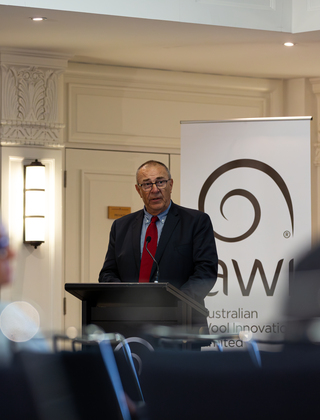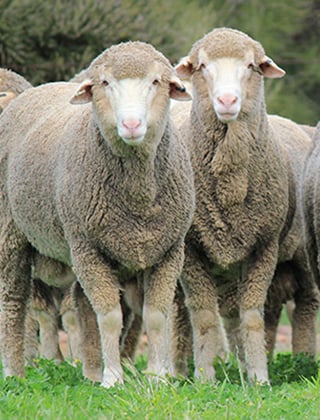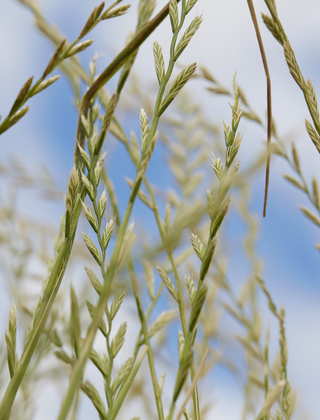Australian Wool Production Forecast Report December 2017
The Australian Wool Production Forecasting Committee forecasts that shorn wool production will lift in 2017/18 to 345 mkg greasy, up by 1.4% compared with 2016/17. The increase in shorn wool production in 2017/18 reflects an increase the number of sheep shorn as producers respond to the high wool prices. This will be partly offset by a small fall in the average wool cut per head due to drier seasonal conditions in some regions, notably in Western Australia.
- The Australian Wool Production Forecasting Committee forecasts that shorn wool production will lift in 2017/18 to 345 mkg greasy, up by 1.4% compared with 2016/17.
- The increase in shorn wool production in 2017/18 reflects an increase the number of sheep shorn as producers respond to the high wool prices. This will be partly offset by a small fall in the average wool cut per head due to drier seasonal conditions in some regions, notably in Western Australia.
The Australian Wool Production Forecasting Committee (AWPFC) has revised its forecast of shorn wool production for the 2017/18 season upwards to 345 million kilograms greasy, a 1.4% increase on its final estimate of 340 mkg for the 2016/17 season.
Committee Chairman, Russell Pattinson said that "seasonal conditions in the major sheep producing areas across Australia were very mixed through Winter and into Spring. Large areas of New South Wales, Queensland, Western Australia and parts of Victoria, South Australia and Tasmania experienced very dry conditions from July to September. Western Australia, in particular, is being affected after the exceptional season in 2016/17. Despite this, Spring shearing in New South Wales and Queensland has benefited from the good seasonal conditions seen for at least part of 2016/17, resulting in good fleece weights to date. Fleece weights could pull back as the season progresses.
"Other regions have seen excellent conditions, notably in the western half of Victoria and the south-east of South Australia. Fleece weights in these regions have been good and are likely to increase in these states as a result.
"The high and rising wool prices have encouraged producers to shear their sheep and deliver as quickly as possible into the market. In some cases, producers are reported to be shearing earlier than usual to take advantage of these high prices. This has boosted the volume of wool tested and wool being offered at auction in the first five months of the season.
"The weight of wool tested by AWTA in the first five months of 2017/18 is up by 5%, but the Committee expects that wool volumes will slow in the second half of the season, partly because some clips that are usually delivered in the second half of the season have already been sold."
By state, the Committee predicts that shorn wool production will increase in New South Wales, Victoria, South Australia and Tasmania in 2017/18. In contrast, shorn wool production in Western Australia and Queensland is expected to fall, with production in Western Australia dropping most.
The Committee noted that for the 2017/18 season to November, the AWTA test data showed a significant decline in the weight of wool tested of 16.5 microns and finer. There has also been a decline in 21 micron wool and wool between 24 and 26 micron. Wool volumes have increased for other micron ranges, with substantial percentage increases for wool broader than 28.5 micron. The average mean fibre diameter for the season to November was 20.8 micron, up by 0.1 micron. Victoria, Tasmania and Queensland have all recorded a 0.3 micron lift in mean fibre diameter for the season, while Western Australia has seen a fall of 0.4 micron. The average staple length has fallen by 1.7 mm in the first five months to 88.4 mm, with all states except for Tasmania recording shorter staple length.
| Table 1: Summary of wool production estimates and forecasts for Australia | |||||
| Parameter | 2015/16 Final Estimate |
2016/17 Final Estimate |
Change y-o-y (%) | 2017/18 Second Forecast |
Change y-o-y (%) |
| Sheep numbers shorn (million head) |
73.4 | 74.3 | +1.2% | 75.0 | +1.7% |
| Average cut per head (kg/head) |
4.43 | 4.58 | +3.4% | 4.56 | -0.3% |
| Shorn wool production (mkg greasy) |
325 | 340 | +4.7% | 345 | +1.4% |
| Note: Totals may not add due to rounding | |||||
| Table 2: Total shorn wool production by state - 2015/16, 2016/17 and 2017/18 | |||||||
| mkg greasy | NSW | VIC | WA | SA | TAS | QLD | National |
| 2015/16 Final Estimate (mkg) | 122.9 | 66.1 | 65.2 | 54.8 | 9.1 | 6.9 | 325 |
| 2017/18 Final Estimate (mkg) | 126.0 | 67.4 | 71.1 | 57.9 | 9.2 | 8.5 | 340 |
| Change y-o-y % | +2.6% | +2.0% | +9.1% | +5.6% | +1.5% | +23.0% | +4.7% |
| 2017/18 Third Forecast (mkg) | 129.4 | 71.7 | 62.7 | 59.1 | 9.8 | 8.3 | 345 |
| Change y-o-y % | +2.6% | +6.3% | -3.6% | +2.2% | +5.9% | -2.6% | +1.4% |
| Note: Totals may not add due to rounding | |||||||
The National Committee drew on advice from the six State Committees, each of which includes growers, brokers, private treaty merchants, representatives from State Departments of Agriculture, and the Australian Wool Testing Authority. Data and input was also drawn from AWTA, AWEX, wool exporters, the Australian Bureau of Statistics, ABARES, and Meat and Livestock Australia.
















